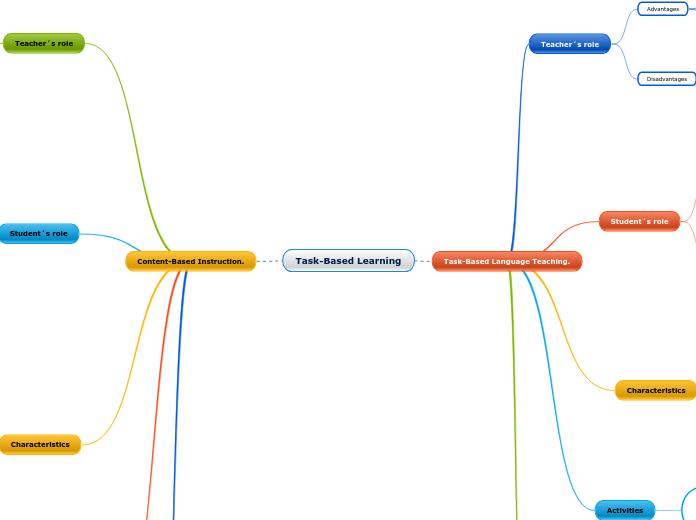Task-Based Learning
Task-Based Language Teaching.
Teacher´s role
Advantages
The teacher guides students on how to complete assignments.
The teacher accompanies and supervises the activity to check the procedures.
The teacher doesn´t abuse his authority
Disadvantages
The teacher spends a lot of time designing the assignments.
The teacher is not in control of the development of the tasks.
Instructions must be clear and motivational activities or students will become frustrated or bored.
Student´s role
Advantages
Working in pairs and groups can strengthen friendship bonds and teamwork skills.
Students observe how language works in communication.
Students are autonomous
Disadvantages
some students do not feel comfortable working as a team
Students may not see the difference in grammatical structures when speaking.
Students can get stuck if they are unable to resolve the lack of language skills.
Characteristics
It gives an emphasis on learning to
communicate through interaction in the
target language
It introduces authentic texts into the learning
situation
It provides opportunities for learners to focus, not only on language, but also on the learning process itself
It enhances the learner’s own personal experiences as important contributing elements to classroom learning
It attempts to link classroom language
learning with language activation outside the classroom.
Activities
Task-based learning is a method for teaching foreign languages where the teacher guides as many activities as possible to his students, such as writing articles, oral presentations, creating summaries, etc. ; then the grammatical analysis of the structures in which the students have difficulties is carried out.
Materials
Pedagogic materials
Advantages
Classroom books have activities already designed to be used in different ways, which save time to teachers
Disadvantages
Books might be boring and lack of real-word language
Realia
Advantages
visually interesting and captures the attention of the learner useful to help your students grasp the cultural differences or learn practical skills
Disadvantages
Spending too much time in one activity with real objects in the class
Content-Based Instruction.
Teacher´s role
Advantages
Teachers adjust their teachings to the learning needs of their students
Professional development helps teachers introspect and reflect on their teaching practices, leading to contextualized learning. In other words, through professional development, teachers have the opportunity to improve their knowledge and teaching skills.
Disadvantages
Teachers may feel anxious when faced with these kinds of challenges
The teacher spends a lot of time preparing the material
Student´s role
Advantages
Learners may acquire the language more willingly
Students feel motivated because the content involves a topic that may be interesting to them
Act autonomously. The student should consult, on her own account, topics that expand not only the content but also aspects of the language that she considers that he should expand.
Think critically, what you achieve by relating, comparing and evaluating the information that is presented to arrive at a reasoned position on the subject at hand.
Disadvantages
If the students' language level is low, it may be difficult to find texts that they understand.
Learners may show a certain degree of anxiety or confusion because this type of instruction is not explicitly done to learn the language.
There could be an excessive use of the mother tongue as students could use it to communicate their ideas quickly and easily.
Characteristics
Students learn a language most effectively when they use the language as a means of communication. In addition, this approach helps them to reflect on the needs to learn a language
When teaching through content, the dual relationship of language-content is consolidated since language is a system that relates what is discussed (content) with the medium used for discussion (expression)
This approach integrates the four skills (listening, speaking, reading and writing) and connects in some way with the natural academic endeavor
This type of instruction motivates students since the content involves a topic that they may find interesting. Students who are highly motivated build more elaborate mental schemes, which leads to improving their connections and remembering information
This approach allows developing cognitive and critical thinking skills due to the activities, challenges and authentic texts offered by this modality
Activities
The teacher must include in their pedagogical practices different linguistic activities that are derived from the content of the subject. It is necessary that in these activities the four skills (listening, speaking, reading and writing) are exercised and that the central axis is the subject of content in question.
Teachers should seek support in readings that deal with different methodological topics such as the deductive method (from the general to the particular), the inductive method (discovery), the comparative method (similarities and differences), the use of the Internet, group activities and individual, tutorials, use of visual and sound material, authentic material, among others. Likewise, they must have knowledge about the different learning styles or intelligences (logical-mathematical, linguistic, spatial, musical, corporal-kinesthetic, intrapersonal, interpersonal, naturalistic) of their students.
Materials
The text must include academic content that is related to the cultural environment of the language learners.
The exercises should be gradual and differentiation to facilitate language learning.
It should have eye-catching images that illustrate the topic at hand.
It´s necessary that it contains exercises to activate prior knowledge, that it provides new information and that requires an analysis from the students for the application in their contexts (the teacher could be guided by the "before, during and after" exercise routine)
It is important that it contains exercises that encourage interaction: between the text and the student, and between the students themselves. Interaction must be a fundamental condition in content courses.
